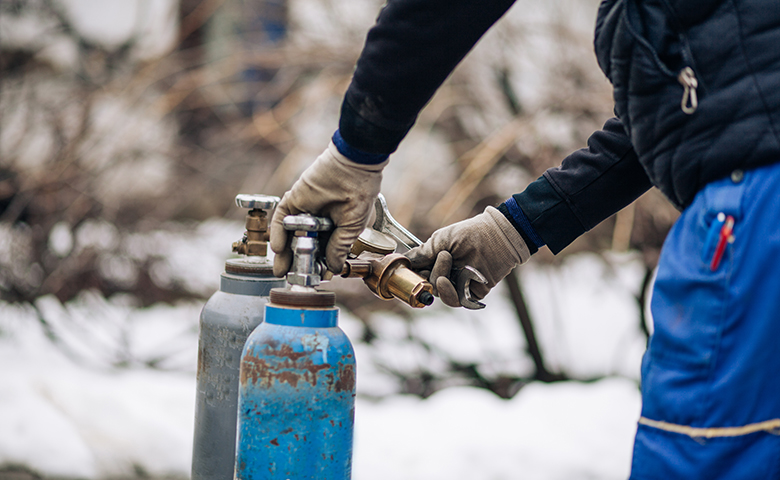The Occupational Safety and Health Administration has set out stringent regulations for transporting, storing and using propane. The need for these guidelines is clear, given that propane and propane cylinders can be a huge source of hazardous energy.
But that doesn’t change the fact that OSHA’s propane rules are complicated. And they may not even be sufficient to keep workers safe, as there are a number of issues that can quickly become compromised or can fall by the wayside.
To that end, here are four often-overlooked areas of concern when it comes to propane safety.
PPE
Personal protective equipment should be worn by workers who are connecting or disconnecting propane cylinders. This is because people can be severely injured if hoses are damaged, there’s a malfunction, or some other problem leads to a leak or other issue.
This requirement is a mainstay of the OSHA propane standard. It’s also in keeping with general workplace safety principles, as PPE is widely required for a variety of jobs in every industry. And that means the common impediments to PPE use are also at play when working with propane.
Many different factors can affect PPE use, from ill-fitting or uncomfortable equipment to states of mind like complacency or overconfidence. If you take propane safety seriously, consider taking a hard look at the influences that could impact PPE compliance among your workers. And keep in mind that just because workers are required to wear protective equipment when handling propane doesn’t mean they’ll actually do it.
Environmental conditions
The most obvious impact the physical environment can have on propane safety is temperature. Cylinders should not be allowed to get too hot, and exposure to heat and sun is a significant concern, especially during summer months. Workers also need to keep an eye on anywhere that propane is stored—if it’s not well ventilated or it allows heat to build up then problems could quickly arise.
But just because it’s obvious to you doesn’t mean that it is to every employee who works with propane, especially if the sudden arrival of hot weather hasn’t given them a chance to recalibrate their risk perception.
Another environmental factor that’s easy to overlook is slip or trip hazards. Any time there’s a risk of someone losing their footing while carrying or working with a propane cylinder (or falling into stored cylinders), there’s an attendant chance of damaging a cylinder, which could cause an immediate larger incident or lead to problems down the road.
The same goes for locations that use forklifts to transport propane. Anything that might cause the forklift to tip or to lose some of its load could lead to dropped cylinders. It’s never a bad idea to remind workers about forklift safety in a safety meeting. You can also offer frequent refreshers on safety issues related to propane-powered equipment.
Training
A certain amount of training is required for some jobs pertaining to propane. But this type of mandatory training only goes so far. Often, folks will conduct compliance training and then think that they’re all set. But just because the training has happened doesn’t mean that it’s going to stick.
Compliance training for propane can be quite dry, and if the material isn’t engaging then workers will be less likely to recall key pieces of information when they need it most. There is also the forgetting curve, which is the natural state of memory declining over time. The further workers are from their last training session, the more of the propane safety training they will have forgotten.
All of which is to say, just because workers have sat through training doesn’t mean they have internalized all of it or will have access to all of the information months after they learned it. This is why frequent reminders of key safety issues can be crucial—because you don’t want to leave everything to your long-term memory.
Human factors
All sorts of human factors can influence how workers handle propane cylinders, operate propane-powered vehicles, and otherwise work with and around propane. Experienced workers could become complacent and start taking safety shortcuts. Employees who are in a rush could fail to wear PPE or might skip inspecting equipment. Frustrated workers could end up handling cylinders too roughly, which can lead to dents or improper storage. These physical and mental states can also compound the issues above to cause additional safety risks.
The quickest way to mitigate the dangers of human factors is by providing a solid education on how workers can recognize and respond to those factors in real time. When employees understand that states like rushing, frustration, fatigue and complacency can increase the risk of a propane-related incident—and are taught what steps they can take to counteract those human factors—they will be much safer.
A secondary benefit to human factors training is that it will also reduce the threat posed by these other propane safety issues. It will improve PPE compliance, increase situational awareness that will help them notice environmental issues, and can dampen the effects of the forgetting curve.
Even better, it also paves the way for more advanced safety engagement. After human factors training has been conducted, many safety managers find that they can get more traction with safety soft skills and other engagement tactics.
You need to be on the lookout for these four major safety issues if your workers handle propane in any way, whether it’s a small part of their job or it’s one of their primary tasks. While any attempt to curtail them is worthwhile, human factors training is likely the most effective intervention you can make across the board. Propane safety is a serious concern, and it’s worth the time and effort to protect workers from potentially deadly propane incidents.

